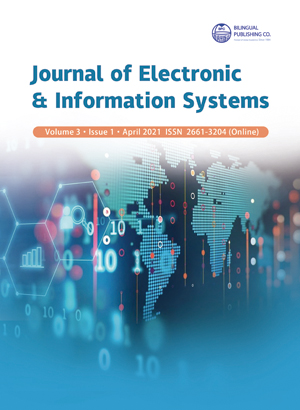-
6473
-
1731
-
1204
-
1120
-
1086
Study the Multiplication M-sequences and Its Reciprocal Sequences
DOI:
https://doi.org/10.30564/jeisr.v3i1.3507Abstract
M-Sequences play a big important role, as the other binary orthogonalsequences, for collection the information on the input links and distributionthese information on the output links of the communication channelsand for building new systems with more complexity, larger period, andsecurity, through multiplication these sequences. In our article we try tostudy the construction of the multiplication sequence {zn}and its linearequivalent, this multiplication sequence is as multiple two sequences, thefirst sequence{an}is an arbitrary M-sequence and the second sequence{bn}is not completely different but is the reciprocal sequence of the firstsequence {an} that is the reciprocal sequence has characteristic polynomialg(x) is reciprocal of f(x), which is the characteristic polynomial of the firstsequence {an}, also we will study the linear equivalent of the multiplicationsequence {zn}and we will see that the length of the linear equivalent of {zn}is equal to ((deg f(x))2 - deg(f(x)).Keywords:
Binary sequences, Finite fields, Shift register, Equivalent binary linear shift register, Degree of complexityReferences
[1] Sloane, N.J.A., (1976), “An Analysis Of The Stricture And Complexity of Nonlinear Binary Sequence Generators,” IEEE Trans. Information Theory Vol. It 22 No 6, PP 732-736.
[2] Jong-Seon No, Solomon W. & Golomb, (1998), “Binary Pseudorandom Sequences For period 2n-1 with Ideal Autocorrelation, ”IEEE Trans. Information Theory, Vol. 44 No 2, PP 814-817.
[3] Golamb S. W. (1976), Shift Register Sequences, San Francisco – Holden Day.
[4] Lee J.S &Miller L.E, (1998), ”CDMA System Engineering Hand Book, ”Artech House. Boston, London.
[5] Yang S.C,”CDMA RF , (1998), System Engineering,”Artech House. Boston- London.
[6] Yang K , Kg Kim y Kumar l. d, (2000), “Quasi–orthogonal Sequences for code –Division Multiple Access Systems, “IEEE Trans .information theory, Vol. 46, No3, PP 982-993.
[7] Mac Wiliams, F. G & Sloane,N.G.A., (2006), “The Theory of Error- Correcting Codes,” North-Holland, Amsterdam.
[8] Kasami, T. & Tokora, H., (1978), “Teoria Kodirovania, ” Mir(Moscow).
[9] Al Cheikha. A. H., (2020), “Study the Linear Equivalent of the Binary Nonlinear Sequences”. International Journal of Information and Communication Sciences. Vol. 5, No. 3, 2020, pp. 24-39.
[10] Al Cheikha A. H. (May 2014), “Matrix Representation of Groups in the finite Fields GF(pn)”International Journal of Soft Computing and Engineering, Vol. 4, Issue 2, PP 118-125.
[11] Lidl, R.& Pilz, G., (1984), ”Applied Abstract Algebra,” Springer – Verlage New York, 1984.
[12] Lidl, R. & Niderreiter, H., (1994), “Introduction to Finite Fields and Their Application, ” Cambridge university USA.
[13] Thomson W. Judson, (2013), “Abstract Algebra: Theory and Applications,” Free Software Foundation.
[14] Fraleigh, J.B., (1971), “A First course In Abstract Algebra, Fourth printing. Addison- Wesley publishing company USA.
[15] David, J., (2008), “Introductory Modern Algebra, ”Clark University USA.




 Ahmad Al Cheikha
Ahmad Al Cheikha





